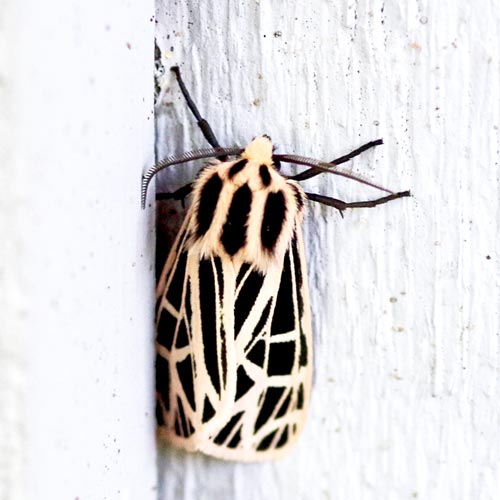Howdy, BugFans,
It’s a Virgin tiger moth (Grammia virgo—probably), a member of a large group of sometimes dramatically patterned moths who whose fuzzy offspring are called “wooly bears” or “wooly worms” (the familiar, rust-and-black, “weather-predicting” wooly bear caterpillar is the offspring of the Isabella Tiger Moth). Depending on whose book you read, VTMs might be placed in the family Arctidae or be listed as a subfamily in the family Erebidae. Arctidae is the older designation; Erebidae is a newer and not-universally-embraced family that combines the owlet, tiger, and tussock moth families.
Tiger Moths
The BugLady is content to let the lepidopterists duke it out; wherever it lands, the VTM is a tiger moth. Tiger moths are unusual among moths because they have on their thorax tymbal organs, which can be used to produce ultrasonic sound (more about that in a sec), and tympanal (hearing) organs (if you’re going to make sound, it’s nice to be able to hear sound). “Ears” are somewhat more common in moths, but some (maybe all) tiger moth caterpillars can hear, too, picking up sound through some of their hairs.
As far as their predators are concerned, the tiger moth bunch packs a gustatory wallop, both as caterpillars and adults. TM caterpillars, which are not generally considered plant pests, are fairly catholic feeders on low herbaceous and woody vegetation like plantain, clovers, bedstraw (VTM caterpillars especially like bedstraw), goosefoot, lettuce, and willow, and the toxic chemicals they consume from their food plants are off-putting to predators. The toxins may remain with them through metamorphosis and into adulthood, and the “toxic edge” continues when females transmit protective chemicals to their eggs.
There are about a dozen confusing Grammia tiger moths, and their caterpillars are also difficult to tell apart. Beneath the VTM’s snappy exterior lies a surprise—brightly-colored hind wings. Most VTMs have rosy hind wings with black splotches, but a small number of moths wear yellow. Here’s a moth with its wings open, and here’s the caterpillar .
Tiger moth species get the word out about their inedibility both with their striking colors/patterns (aposematic/warning coloration) and/or by using their characteristic ultrasonic emanations to startle bats, to warn bats to stay away, or to “jam” the bat radar. Researchers John Ratcliffe and Marie Nydam studied these “multimodal signals”—visual signals that protect moths during the day and auditory signals for those active in the night. Multimodal signals might simply deliver a more comprehensive message to a single predator, or they may address multiple predators in the languages they understand. The researchers correlated the signaling style with the flight periods and the nocturnal/diurnal habits of 26 species of tiger moth. They found that tiger moths that were active in spring and in the daytime were brightly colored and used visual cues to deter birds; species that emerged later in summer and flew at night used clicking to discourage bats.
VTMs can do it all, and more! They are late season moths (therefore more worried about bats than birds), but they are abroad at any time of the day or night, so they have a striking pattern on the fore wings (the markings of the genus Grammia are said to have given the group its Tiger Moth nickname), flashy hind wings (when mistreated, they play possum, flipping over, curling up their abdomen, and showing off their hind wings), and they can click at the bats at night. In case there are any predators left undecided, VTMs also produce a defensive chemical foam. Wagner, in Caterpillars of North America, says, “Adults, when gently squeezed, may bubble generous amounts of their yellow “blood” out of the front corners of the thorax, yielding a frothy mass that contains alkaloids that the caterpillar has consumed.”
Their taste (and their distinctive odor) have elicited comment for some time. In 1859, the very not-PC Thaddeus William Harris wrote in A Treatise on Some of the Insects of New England: Which are Injurious to Vegetation that “The largest and most rare of these moths is the Arctia virgo, or virgin tiger moth. On account of the peculiarly strong and disagreeable odor it gives out, it might, with greater propriety, have been named the stinking tiger moth.” In The Life of North American Insects, also published in 1859, Jaeger and Preston state that “The Virgin Tiger Moth (Arctia virgo) is one of the handsomest and largest of this genus, but on account of its fetid odor it is very disagreeable to handle.
Sounds and scents figure into tiger moth courtship, too. Females “call” males by emitting a pheromone (perfume) plume that males can sense with their antennae. Males send out ultrasonic signals to females before releasing their own chemical signals, and when he’s getting close to her, he may click and she may answer. When males of some species emit certain odors, it demonstrates to the female that he can give her the chemical that will protect her eggs. There is one generation per year, and VTMs overwinter as caterpillars; waking up to continue eating in spring and eventually incorporating some of their own body hairs into their silken cocoons.
The VTM is found in woodland and wetland edges, clearings and fields east of the Rockies, though it’s uncommon in the far South. Its internet presence consists mainly of its inclusion on lists, surveys and museum collections, but because of its general spiffiness, there are lots of photos and even some artistic renderings.
No, the BugLady didn’t see an explanation for the “Virgin” part of the name.
The BugLady
